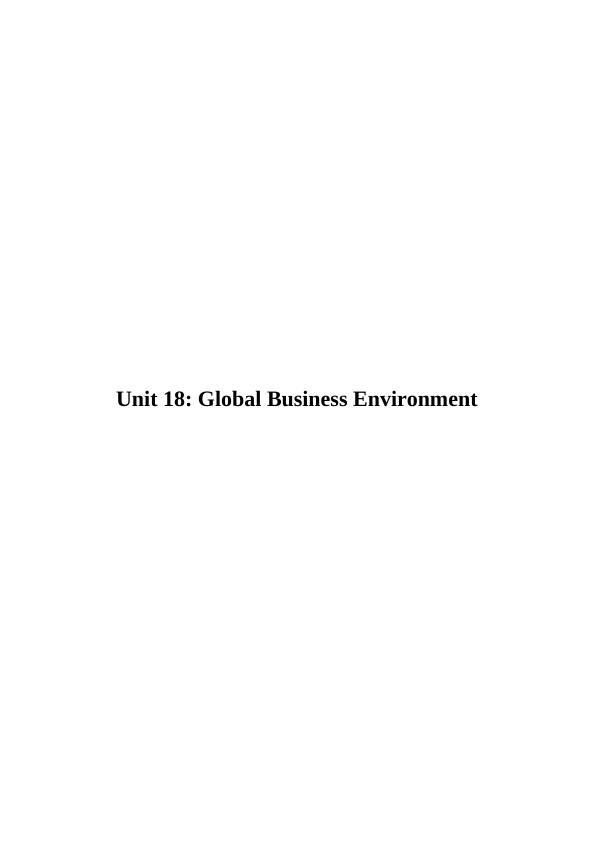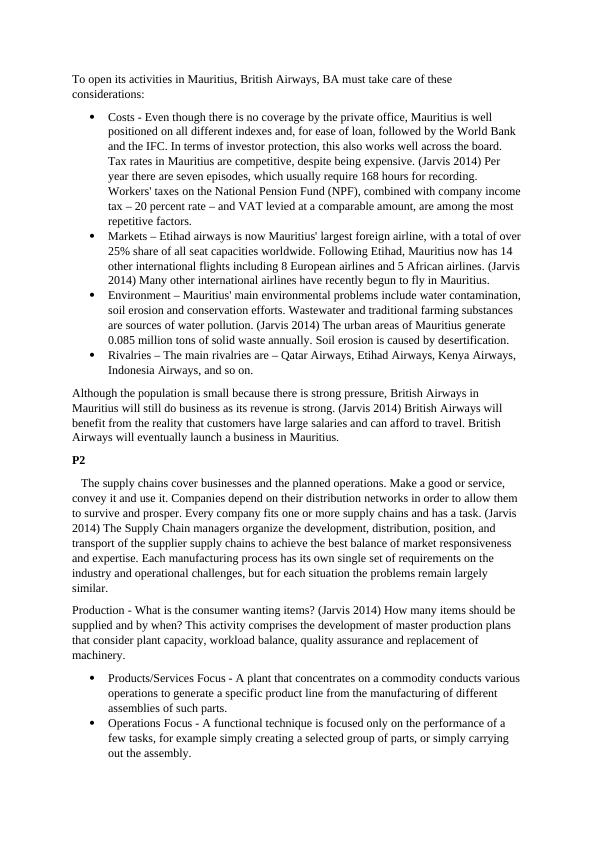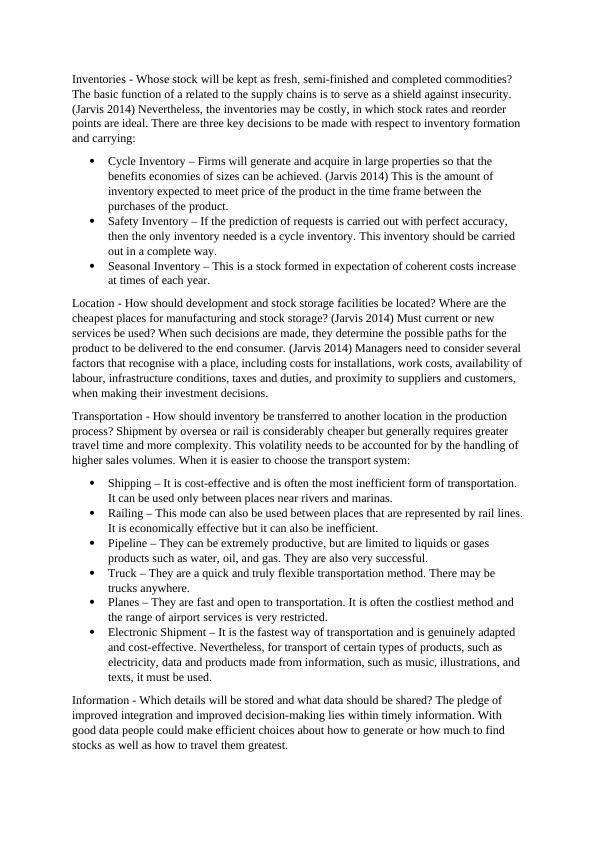Ask a question from expert
Unit 18 Global Business Environment - Assignment
13 Pages6298 Words55 Views
Added on 2021-03-03
Unit 18 Global Business Environment - Assignment
Added on 2021-03-03
BookmarkShareRelated Documents
Unit 18: Global Business Environment

IntroductionBecause of reduced prices, and lower costs generally, better efficiency or product creativity businesses may succeed in all industries. The 'choice' is usually presented in civil aviation as one between either low costs or high quality / service innovations. (Jarvis 2014) Nonetheless, airlines are constantly having to perform on all three factors as, in an unsound setting, the cycle of imitation is becoming quicker, and rendering it impossible for each carrier to retain competitive advantages on the basis only of service efficiency or product developments.P1Mauritius Air, which accounts for 76% of its domestic output and 56% of foreign output in 2008, is the largest airline in Mauritius. Air Austral, headquartered in Reunion, Air France, Emirates, South AfricanAirways and British Airways, and were the top international air linesserving Mauritius in 2008. (Jarvis 2014) In 1995 the British and U.S. governments decided tochanges to the original Bermuda II arrangement to require additional airports that effectively deregulated most of the United Kingdom-US. However, the privileges of seventh rights for transport services are very unusual. (Corke 2006) In addition, certain factors must be considered: cost, market, environment, and competition:Cost – In addition to clear cost factors such as delivering and innovation tracking for logistical tasks, the Company should also be paying for cost elements in its marketing,financial and business divisions.R & D – Perhaps overseas, what operates well in a nation does not work. Enterprises must examine facilities, society, and community in order to survive.Exchange Rates – Leading international companies need to exchange the foreign currency of the host country with the legal tender of the foreign country. (Jarvis 2014)The transfer scene will only wobble within seconds, though, so money dealing can be exorbitant so dangerous.Tax – International corporations are subject to international market taxes. Intentionally, the governments of several countries established a low tax rate to enablecompanies to open to enterprises inside their territories.Population – In one nation or market, the potential client population varies greatly depending on the product or service that a company market.Income – Many eyewitnesses agree that wage level is a key model to determine the target markets.Marketing Trends – Market patterns offer industry and the economy logical meaning by depicting existing behaviours and their budgetary development.Projections – The majority of market analyses also include a sector which shows the competition of the company with a similar evaluation applied to the research company.Rivalries – This are the main external element that can affect a company's strategy.(Jarvis 2014) Environmental regulations are a business' obligation to the rules, legislation and other regulatory instruments dealing with the environment.Environmental Policies – They are the main external element that can affect a company's strategy. (Jarvis 2014) Environmental regulations are a business' obligationto the rules, legislation and other regulatory instruments dealing with the environment.

To open its activities in Mauritius, British Airways, BA must take care of these considerations: Costs - Even though there is no coverage by the private office, Mauritius is well positioned on all different indexes and, for ease of loan, followed by the World Bank and the IFC. In terms of investor protection, this also works well across the board. Tax rates in Mauritius are competitive, despite being expensive. (Jarvis 2014) Per year there are seven episodes, which usually require 168 hours for recording. Workers' taxes on the National Pension Fund (NPF), combined with company incometax – 20percent rate – and VAT levied at a comparable amount, are among the most repetitive factors.Markets – Etihad airways is now Mauritius' largest foreign airline, with a total of over25% share of all seat capacities worldwide. Following Etihad, Mauritius now has 14 other international flights including 8 European airlines and 5 African airlines. (Jarvis 2014) Many other international airlines have recently begun to fly in Mauritius.Environment – Mauritius' main environmental problems include water contamination,soil erosion and conservation efforts. Wastewater and traditional farming substances are sources of water pollution. (Jarvis 2014) The urban areas of Mauritius generate 0.085 million tons of solid waste annually. Soil erosion is caused by desertification.Rivalries – The main rivalries are – Qatar Airways, Etihad Airways, Kenya Airways, Indonesia Airways, and so on. Although the population is small because there is strong pressure, British Airways in Mauritius will still do business as its revenue is strong. (Jarvis 2014) British Airways will benefit from the reality that customers have large salaries and can afford to travel. British Airways will eventually launch a business in Mauritius.P2 The supply chains cover businesses and the planned operations. Make a good or service, convey it and use it. Companies depend on their distribution networks in order to allow them to survive and prosper. Every company fits one or more supply chains and has a task. (Jarvis 2014) The Supply Chain managers organize the development, distribution, position, and transport of the supplier supply chains to achieve the best balance of market responsiveness and expertise. Each manufacturing process has its own single set of requirements on the industry and operational challenges, but for each situation the problems remain largely similar.Production - What is the consumer wanting items? (Jarvis 2014) How many items should be supplied and by when? This activity comprises the development of master production plans that consider plant capacity, workload balance, quality assurance and replacement of machinery. Products/Services Focus - A plant that concentrates on a commodity conducts various operations to generate a specific product line from the manufacturing of different assemblies of such parts.Operations Focus - A functional technique is focused only on the performance of a few tasks, for example simply creating a selected group of parts, or simply carrying out the assembly.

Inventories - Whose stock will be kept as fresh, semi-finished and completed commodities? The basic function of a related to the supply chains is to serve as a shield against insecurity. (Jarvis 2014) Nevertheless, the inventories may be costly, in which stock rates and reorder points are ideal. There are three key decisions to be made with respect to inventory formationand carrying:Cycle Inventory – Firms will generate and acquire in large properties so that the benefits economies of sizes can be achieved. (Jarvis 2014) This is the amount of inventory expected to meet price of the product in the time frame between the purchases of the product.Safety Inventory – If the prediction of requests is carried out with perfect accuracy, then the only inventory needed is a cycle inventory. This inventory should be carried out in a complete way.Seasonal Inventory – This is a stock formed in expectation of coherent costs increase at times of each year.Location - How should development and stock storage facilities be located? Where are the cheapest places for manufacturing and stock storage? (Jarvis 2014) Must current or new services be used? When such decisions are made, they determine the possible paths for the product to be delivered to the end consumer. (Jarvis 2014) Managers need to consider severalfactors that recognise with a place, including costs for installations, work costs, availability oflabour, infrastructure conditions, taxes and duties, and proximity to suppliers and customers, when making their investment decisions.Transportation - How should inventory be transferred to another location in the production process? Shipment by oversea or rail is considerably cheaper but generally requires greater travel time and more complexity. This volatility needs to be accounted for by the handling of higher sales volumes. When it is easier to choose the transport system: Shipping – It is cost-effective and is often the most inefficient form of transportation. It can be used only between places near rivers and marinas.Railing – This mode can also be used between places that are represented by rail lines.It is economically effective but it can also be inefficient.Pipeline – They can be extremely productive, but are limited to liquids or gases products such as water, oil, and gas. They are also very successful.Truck – They are a quick and truly flexible transportation method. There may be trucks anywhere.Planes – They are fast and open to transportation. It is often the costliest method and the range of airport services is very restricted.Electronic Shipment – It is the fastest way of transportation and is genuinely adapted and cost-effective. Nevertheless, for transport of certain types of products, such as electricity, data and products made from information, such as music, illustrations, and texts, it must be used.Information - Which details will be stored and what data should be shared? The pledge of improved integration and improved decision-making lies within timely information. With good data people could make efficient choices about how to generate or how much to find stocks as well as how to travel them greatest.

End of preview
Want to access all the pages? Upload your documents or become a member.
Related Documents
Business Environment Of British Airways PDFlg...
|6
|1296
|258
Business Environment of British Airways Companylg...
|15
|5660
|286
Business Environment Contents Introduction to British Airwayslg...
|12
|4407
|219
External Business Factors for Qantas Airways: PESTLE Analysislg...
|9
|2243
|298
Contemporary Business Issues in British Airways: A Critical Analysis of Sustainabilitylg...
|15
|3035
|116
Strategic Analysis of British Airwayslg...
|13
|2955
|94